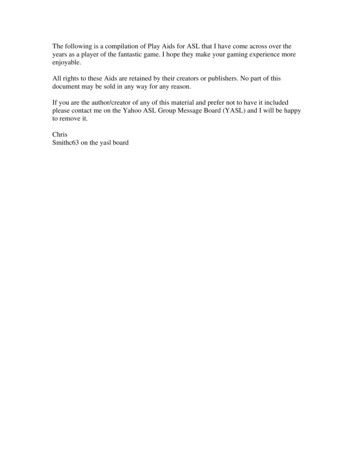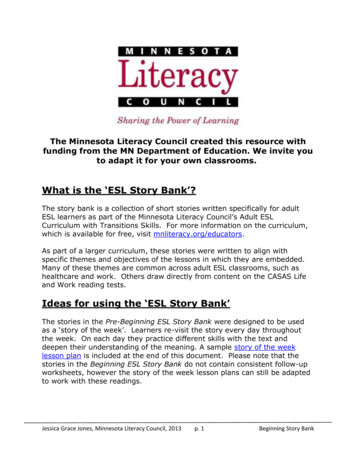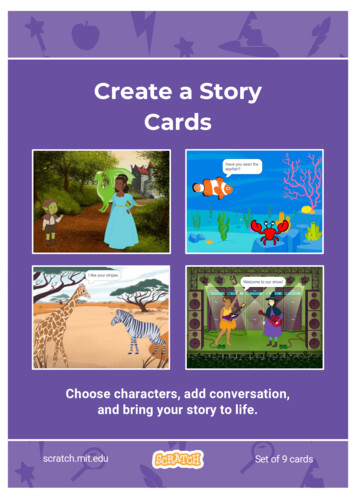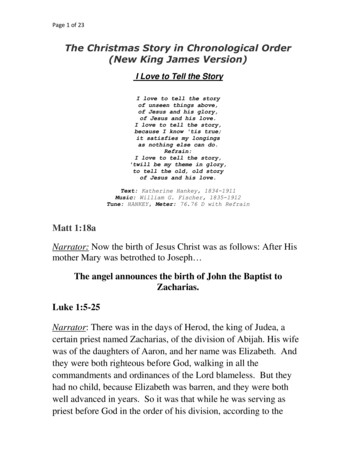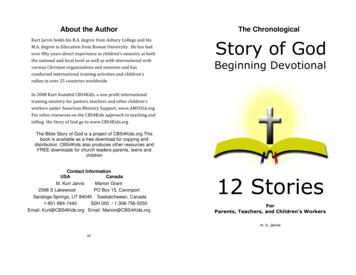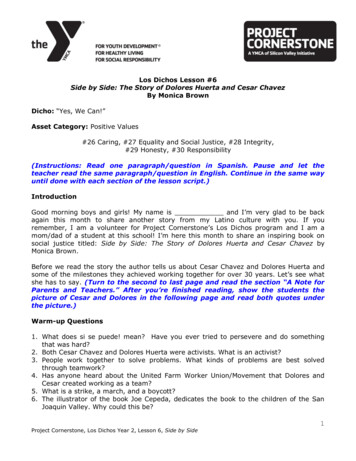
Transcription
Los Dichos Lesson #6Side by Side: The Story of Dolores Huerta and Cesar ChavezBy Monica BrownDicho: “Yes, We Can!”Asset Category: Positive Values#26 Caring, #27 Equality and Social Justice, #28 Integrity,#29 Honesty, #30 Responsibility(Instructions: Read one paragraph/question in Spanish. Pause and let theteacher read the same paragraph/question in English. Continue in the same wayuntil done with each section of the lesson script.)IntroductionGood morning boys and girls! My name is and I’m very glad to be backagain this month to share another story from my Latino culture with you. If youremember, I am a volunteer for Project Cornerstone’s Los Dichos program and I am amom/dad of a student at this school! I’m here this month to share an inspiring book onsocial justice titled: Side by Side: The Story of Dolores Huerta and Cesar Chavez byMonica Brown.Before we read the story the author tells us about Cesar Chavez and Dolores Huerta andsome of the milestones they achieved working together for over 30 years. Let’s see whatshe has to say. (Turn to the second to last page and read the section “A Note forParents and Teachers.” After you’re finished reading, show the students thepicture of Cesar and Dolores in the following page and read both quotes underthe picture.)Warm-up Questions1. What does si se puede! mean? Have you ever tried to persevere and do somethingthat was hard?2. Both Cesar Chavez and Dolores Huerta were activists. What is an activist?3. People work together to solve problems. What kinds of problems are best solvedthrough teamwork?4. Has anyone heard about the United Farm Worker Union/Movement that Dolores andCesar created working as a team?5. What is a strike, a march, and a boycott?6. The illustrator of the book Joe Cepeda, dedicates the book to the children of the SanJoaquin Valley. Why could this be?1Project Cornerstone, Los Dichos Year 2, Lesson 6, Side by Side
Read the Story(Read the story in Spanish a page at a time and have the teacher read the samepage in English. Remember to show the illustrations.)Discussion Questions1. What is La Causa? What were Cesar and Dolores fighting for?2. Under what conditions did farmworkers have to work and live? How were the kids ofthe farmworkers affected?3. What were some examples of non-violent acts Cesar and Dolores did during theirstruggle for social justice?Did you know that Cesar Chavez . . . Was a vegetarian. Lived in San Jose. Had two dogs - one named Huelga and the other one Boycott. Looked up to Mahatma Gandhi & Martin Luther King Jr. for inspiration. Is honored with a state holiday every March 31st in California and other states.Did you know that Dolores Huerta Received many honors for her work as activist. Is over 80 years old and still fighting for social justice. Has visited Silicon Valley many times. Is the president of her own foundation. The Dolores Huerta Foundation focuses onsocial justice.ActivitiesOption 1 — Agents of Social ChangeDolores and Cesar shared the desire to fight against the injustices in the agricultural fieldsaffecting many farmworkers. They believed that it was unfair for the farmworkers to do allthe hard work of growing and picking the crops, but not having enough food on theirtables at the end of the day. They organized and recruited farmworkers to help strike,march, and boycott. They used picket signs during these activities to draw public attentionto their cause. It is also a non-violent way to fight injustice.For today’s activity we will be making individual poster or a large classroom poster toshow the different social justice causes we support.(Offer some examples of causes they can help support. It can be a global, local,community or school issue. Some ideas can be conserving the environment,world hunger, animal rights, poverty, access to education, gender equality, orbullying.)2Project Cornerstone, Los Dichos Year 2, Lesson 6, Side by Side
(Note: Explain to students that their message will be more powerful if they usefewer words on their poster. It is also important for the writing to be big andclear. It will be easier and quicker to read and it will stay in people’s mind for alonger time.)Option 2 — Sí Se Puede! ChainDolores Huerta is famous for saying, “¡Sí, se puede!” (“Yes, we can!”) when many farmworkers doubted that they could band together to improve their lives.For todays’ activity we will first brainstorm ways to bring about change in your classroom,home, and community. Then, we will think about specific ways to make the changeshappen. Finally we will write “I Can” statements on strips of construction paper to linktogether and make a paper chain of change to hang in your classroom. This chain willserve us as a reminder that by working together as a team, we can make change happen!In the front of the strip, you will write the change you would like to focus on.Example: “I can help stop animal abuse.”In the back of strip, you will write the action you will take to make this change happen.Example: “I can have a bake sale for ASPCA.”(If chain cannot be hung in classroom, students can make “I can” braceletsinstead.)3Project Cornerstone, Los Dichos Year 2, Lesson 6, Side by Side
ClosureThank you girls and boys for letting me come into your classroom to share this powerfulstory of the lives of Cesar Chavez and Dolores Huerta and their journeys to social andeconomic justice.Our dicho for this book is Dolores’ famous phrase “¡Sí, se puede!” that motivated thefarmworkers to keep on fighting for better working conditions and serve us as a reminderthat by working together anything is possible. Cesar and Dolores are an inspiration for allwho believe in the fight for social justice.I hope you all learn about the hard work of farmworkers. Next time that you visit thefruits and vegetable section of your grocery store remember the process of how they gotthere. We are able to enjoy delicious fruits and vegetables thanks to the hard work offarmworkers. I look forward to seeing you all next month for another story!4Project Cornerstone, Los Dichos Year 2, Lesson 6, Side by Side
Los Dichos Lección #6Lado A Lado: La Historia de Dolores Huerta y Cesar ChávezDe Monica BrownDicho: “¡Sí se puede!”Categoría de EFD: Valores Positivos#26 Interés Por Los Demás #27 Igualdad y Justicia Social #28 Integridad#29 Honestidad #30 Responsabilidad(Instrucciones: Lea un párrafo o una pregunta en español. Haga una pausa ydeje que la maestra o el maestro lea lo mismo en inglés. Continúe leyendo yhaciendo pausas de la misma forma en cada sección).Introducción¡Buenos días niños y niñas! Mi nombre es y estoy feliz de estar de regresoeste mes para compartir con ustedes otra historia de la cultura latina. Si lo recuerdan, soyvoluntaria(o) del programa Los Dichos de Project Cornerstone ¡y mamá/papá de un(a)estudiante de esta escuela! Este mes estoy aquí para compartir un libro inspirador sobrejusticia social titulado: “Lado A Lado: La Historia de Dolores Huerta y Cesar Chávez” deMonica Brown.Antes de leer la historia, la autora nos cuenta acerca de César Chávez y Dolores Huerta; ysobre algunos de los eventos significativos que lograron trabajando juntos durante más de30 años. Escuchemos lo que ella tiene que decir. (Pase a la penúltima página y lea lasección “Nota para los padres de familia y los maestros”. Cuando usted hayaterminado de leer, muestre a los estudiantes la fotografía de César y Dolores enla siguiente página y lea las citas al pie de la fotografía).Preguntas de calentamiento1. ¿Qué significa ¡si se puede!? ¿Alguna vez has tratado de perseverar y hacer algoque fue difícil?2. César Chávez y Dolores Huerta eran activistas. ¿Qué es un activista?3. Las personas trabajan juntas para resolver problemas. ¿Qué clase de problemas seresuelven mejor gracias al trabajo en equipo?4. ¿Alguno de ustedes ha escuchado acerca de la Unión de Campesinos que Dolores yCésar crearon trabajando en equipo (UFW por sus siglas en inglés)?5. ¿Qué es una huelga, una manifestación y un boicot?6. El ilustrador del libro, Joe Cepeda, le dedica el libro a los niños del Valle de SanJoaquín. ¿Por qué?1Project Cornerstone, Los Dichos Year 2, Lesson 6, Side by Side
Leer el libro(Lea el libro en español. Lea una página a la vez y permita que la maestra o elmaestro lea la versión en inglés cada vez que usted termine con la página.Recuerde mostrar las ilustraciones).Iniciadores de conversación1. ¿Qué es ‘La Causa’? ¿Por qué protestaban César y Dolores?2. ¿Bajo qué condiciones vivían y trabajaban los campesinos? ¿Cómo afectaba esto asus hijos?3. ¿Cuáles fueron algunos ejemplos de actos no violentos que realizaron César yDolores durante su lucha por la justicia social?Sabían que César Chávez Era vegetariano. Vivo en San José. Tenía dos perros: uno llamado Huelga y el otro Boicot. Mahatma Gandhi y Martin Luther King Jr. eran su inspiración. Es honrado con un día festivo en California y otros estados cada 31 de marzo.Sabían que Dolores Huerta Ha recibido muchos honores por su trabajo como activista. Tiene más de 80 años de edad y aún sigue luchando por la justicia social. Ha visitado el Valle del Silicio en muchas ocasiones. Es la presidenta de su propia fundación. La fundación Dolores Huerta se enfoca enla justicia social.ActividadesOpción 1 – Agentes del cambio socialDolores y César compartían el deseo de luchar en contra de las injusticias en el campoque afectaban a muchos campesinos. Ellos opinaban que era injusto que los campesinoshicieran todo el trabajo pesado de cultivar y cosechar los campos y no recibieran losuficiente para poder llevar comida a su mesa al final de la jornada. Organizaron yreclutaron campesinos para que los ayudaran en huelgas, marchando, y con boicots.Durante estas actividades utilizaron pancartas para llamar la atención del público.También fue una forma no violenta de luchar en contra de la injusticia.Para la actividad del día de hoy haremos pancartas individuales o una grande como clasepara mostrar las diferentes causas que apoyamos relacionadas a la justicia social.(Ofrezca algunos ejemplos de causas que pueden apoyar. Pueden ser causasmundiales, locales, sobre algún problema de la comunidad o de la escuela.Algunas ideas son la conservación del medio ambiente, el hambre mundial, losderechos de los animales, la pobreza, el derecho a la educación, la igualdad degénero, o el acoso y/o intimidación.)2Project Cornerstone, Los Dichos Year 2, Lesson 6, Side by Side
(Nota: Explique a los estudiantes que su mensaje será más convincente siutilizan pocas palabras en su pancarta. Es importante también que la escriturasea grande y clara. Se podrán leer más fácil y rápido y el mensaje se quedarágrabado en la mente de las personas por más tiempo.)Opción 2 – Cadena ¡sí se puede!Dolores Huerta es famosa por la frase: “¡Sí se puede!” cuando muchos campesinosdudaban que podían unirse para mejorar su calidad de vida.Para la actividad del día de hoy empezaremos por dar ideas sobre cómo podemos hacerun cambio dentro de nuestro salón de clases, en nuestro hogar y en la comunidad.Después vamos a pensar en formas específicas para que sucedan estos cambios.Finalmente vamos a escribir en tiras de cartulina declaraciones comenzando con la frase:“Yo puedo”. Después vamos a unirlas para formar una cadena que colgaremos en el salónde clases. Esta cadena nos servirá como un recordatorio de que trabajando en equipo¡podemos hacer que pasen muchas cosas!En la parte delantera de la tira, escribirán el cambio en el que desean enfocarse.Ejemplo: “Yo puedo ayudar a acabar con el abuso a los animales.”En la parte posterior de la tira, escribirán la acción que tomaran para que este cambiosuceda.Ejemplo: "Yo puedo tener una venta de pasteles para ASPCA".(Si no es posible colgar la cadena dentro del salón de clases, los estudiantespueden hacer brazaletes con las frases “Yo puedo ”)3Project Cornerstone, Los Dichos Year 2, Lesson 6, Side by Side
CierreGracias niños y niñas por permitirme visitar su salón de clases y compartir con ustedes lahistoria de las vidas de César Chávez y Dolores Huerta y sus recorridos para lograr lajusticia social y económica.Nuestro dicho correspondiente a este libro es la frase famosa de Dolores: “¡Sí se puede!”;la cual motivó a los campesinos a seguir luchando por mejorar sus condiciones de trabajo.Nos sirve como un recordatorio de que trabajando juntos, todo es posible. César y Doloressirven de inspiración para todos los que creen en la lucha por la justicia social.Espero que hayan aprendido acerca del arduo trabajo de los campesinos. La próxima vezque visiten la sección de frutas y verduras en el supermercado, recuerden el proceso decómo llegaron allí. Podemos disfrutar de frutas y verduras deliciosas gracias al arduotrabajo de los campesinos. ¡Nos vemos el próximo mes para contarles otra historia!4Project Cornerstone, Los Dichos Year 2, Lesson 6, Side by Side
2. Both Cesar Chavez and Dolores Huerta were activists. What is an activist? 3. People work together to solve problems. What kinds of problems are best solved through teamwork? 4. Has anyone heard about the United Farm Worker Union/Movement that Dolores and Cesar created working as a team? 5. What is a strike, a march, and a boycott? 6.


